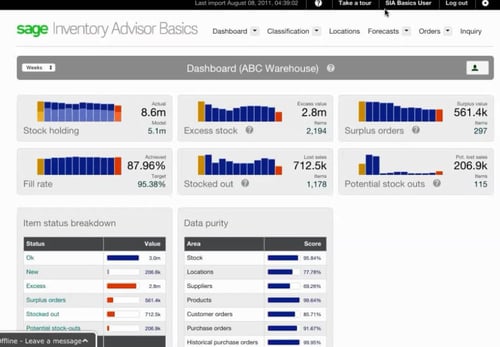
Many businesses that manage inventory choose to do so with an inventory spreadsheet. It’s a common tool used to get some basic information, like which items are in stock and which need to be re-ordered.
Many planners export data from their ERP and drop it into Excel, which seems like a solid workflow and a good use of that data. But if you don’t know exactly what’s in that spreadsheet at all times, your inventory replenishment process is likely to be riddled with hidden costs. It’s time to see if your inventory spreadsheet actually adds up.
Data inputs are critical
Managing that spreadsheet means managing lots of data. Everyone knows that garbage in means garbage out, so as long the sheet has some quality data in there, it should point you in the right direction. Of course, the reality is quite a bit more complicated than that. There are several main challenges when dealing with your data:
- Accuracy
- Synchronization
- Inputs
If you have even just small errors in each of these areas, they will cascade and create a much bigger problem in your warehouse. Think of it this way:
Inaccurate data + unsynchronized data + inadequate planning inputs = weak order recommendations
Managing all of this complex data was meant to accomplish one basic thing: optimal orders. If your spreadsheet hinders you from doing this, then it simply is the wrong tool for your company’s inventory management.
Data complexities pile up
Credible research in the field shows spreadsheets are filled with errors, but let’s say you are an Excel wizard and you’ve figured out all of those issues already. The question you must ask is this: are you capable of dealing with more complex requirements using your old school method?
Those who manage a central warehouse with subsidiary locations certainly know about the complexities of optimal ordering. Similarly, if you have new products routinely take the place of old products and need to include those sale histories to create new forecasts, you’ve got a unique challenge on your hands. And what about bills of materials and kitting? What about interruptions, planned or otherwise? Excel just wasn’t built for these kinds of inventory-specific issues, which is yet another reason why so many inventory spreadsheets fail.
What’s worse is that a failing inventory policy isn’t necessarily obvious. In fact, many planners spend their workdays dealing with an onslaught of minor emergencies in their warehouse. These are managers that don’t have the time to truly audit their spreadsheet and fix various errors while also handling critical day-to-day tasks.
Moving on from your inventory spreadsheet
It’s clear that even the most proficient ERP and Excel users are going to have trouble managing inventory this way. If carrying excess isn’t the long-term answer, what is?
It’s time you looked into an Inventory Management System, also known as an IMS. This may sound like an expensive fix, but a quality IMS can actually pay for itself quite quickly, giving you a return on your investment that grows every time you place an optimal order for your warehouse.
For Sage ERP users, one such IMS option is Sage Inventory Advisor, a cloud-based inventory optimization app that works directly with your ERP. With its easy-to-navigate dashboards, users can reduce stock-outs, eliminate excess stock, and save time when ordering.
RKL eSolutions is proud to support Sage Inventory Advisor. If you’d like to learn more about inventory optimization and how your inventory spreadsheet is hurting your business, click below to get in touch.



